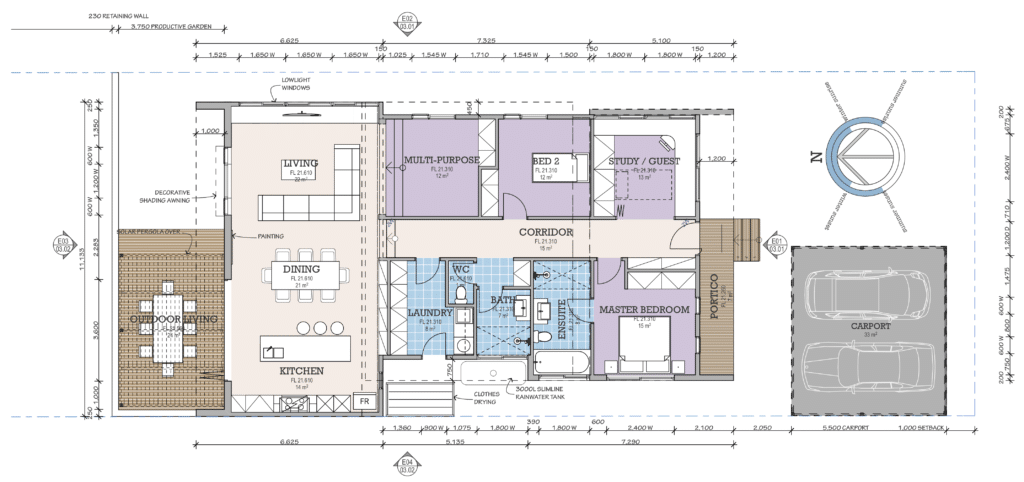Getting your pricing right is always a challenge. Charging too much or too little can both be as detrimental to your business.
Here’s a deceptively simple question: how much would you charge to complete an energy rating of this house design?  There are a plethora of different approaches you can take to getting your pricing right for an energy rating.
There are a plethora of different approaches you can take to getting your pricing right for an energy rating.
Fixed Price
For example, some assessors might have a pricing structure that starts by differentiating between a single or double storey house. This is a good place to start, as a two (or more) storey dwelling will have the floors and ceilings that overlap with the zones above/below – it takes a bit of time and attention to detail to model these different areas accurately, and this complexity should be accounted for in the price to rate a house with one or more storeys. However, there are some limitations to this approach by itself. A house may appear to be single storey in the floor plan, but what if the floors and ceiling heights are at different levels? With this example, the main living area has a raked ceiling with no roof space zone above, which isn’t apparent until you looked at a longitudinal section. You’ll also notice there are steps leading up to the main living area, indicating a change in floor level. These kinds of design features may then require to you calculate different zone volumes and/or to take into account that the internal walls may then vertically overlap with more than one zone. It may just be a single storey house, but that doesn’t necessarily mean the design is simple.

Square Metre Rate
Another approach may be to try and apply a square metre rate across the total floor area of the house. There’s a certain logic to this approach as well – the greater the floor area, the more it will cost to rate the design. However, as noted above, zones that partially overlap with another zone above/below take a bit more time to model. Also, note how with this floor plan, the external walls step in and out around the perimeter of the building. These considerations add another level of complexity when rating this design – a rectangular shaped house with the same floor area would be an easier design to rate, as there would be less external wall area that would need to entered to complete the rating. Interestingly, a house with less external wall area for a given volume of enclosed space will generally achieve a higher rating in most climates, as there is less surface area through which heat gain and loss can occur. This is where including a complexity factor can help to determine how much to charge for rating a particular design. For example, let’s say your square metre rate is $5/sqm (in a future post we’ll talk about how to calculate a rate like this). So if you were rating a single storey house with a floor area of 300sqm, your base fee would be $1,500. If a house had the same area but was a two storey design, you might then apply a complexity factor of 1.2 or 20% ie. $1,500 x 1.2 = $1,800. If the perimeter of the external walls is quite complex and not just a simple rectangle, you might then apply a further complexity factor of 20% ie. $1,800 x 1.2 = $2,160. This approach helps you to charge a more competitive fee when the design is simple, and to also have a consistent approach to how you might account for a more complex design. Another complexity consideration you would be wise to take into account would be the external elevations. Take for example the east elevation of this particular house design:
Adding a Complexity Loading
There are three different types of wall cladding used just on this elevation alone, which may also have different types of corresponding wall construction behind. In some designs, you may also have a different type of wall construction at the base of the wall, such as brick up to the window sill height and then weatherboard cladding up to the eaves height. Because each of these wall sections will need to be modelled individually, this will take additional time which should be factored into your pricing. If you are serious about getting your pricing right, then you need to factor in this extra time.
Calculating how long the job will take
Ultimately, what you are really trying to work out is how long it will take you to model the design in your rating software. Typically we would try and estimate how many hours it would take you to model a particular design. In a future blog, we’ll talk about how to calculate your hourly rate, but in the meantime you’re just trying to be as realistic as possible in estimating how many hours will be required to enter all of the data necessary to be able to obtain a preliminary rating. So how many hours do you think it might take to rate this particular design? Let’s start by using some of the estimate techniques we have discussed to date. It’s a single storey design with a floor area of around 169sqm – though I would also include the area of the outdoor living area as there is a solar pergola that forms part of this that also needs to be modelled as an operable horizontal shading device. This gives us an area of 193sqm. The design is reasonably complex compared to a typically house design – it has different floor levels, varying ceiling heights, a not-so-simple building footprint and various external wall constructions that need to be accounted for. So you might say this design would have a complexity factor of around 2.0 ie. it would take you twice as long to model this design compared to a more conventional one. Assuming the basic square metre rate of $5/sqm mentioned previously, the estimate to rate this design would start from around $1,930.
Now that I’ve got my head around the design and the likely complexities I will encounter, this gives me greater confidence to estimate the hours that will be required. Because I’ve previously done ratings for similarly complex designs, instinctively I think around 20.0 hours would be required to rate this design. The hourly rate I charge for doing ratings is $100/hour – 1930/20 = $96.50 per hour, which suggests I’m close to the mark when estimating the hours and the level of complexity for this project. Lastly, while hourly rates are very useful way to estimate time, I also find it useful to calculate a daily rate for a project as well. For the sake of simplicity, let’s say that there are 7.5 hours in a typical work day. If you estimated 20.0 hours to complete a preliminary rating for the above project, this would take 20.0/7.5 = 2.66 days to complete. I would then round this up and allow 3.0 working days to complete this rating ie. assume at least 22.5 hours will actually be required. Hourly rates assume that when we clock on or off, we can be 100% efficient straight away. In reality, it will frequently take us a while to get into the swing of things, to remember where we left off and so forth.
A work day is also typically interrupted by phone calls, family matters and other often-unavoidable distractions, so for me it makes sense to allow for these contingencies, rather than just get frustrated by them. So 22.5 * $100 = $2250 would be my final estimate to complete an energy rating of this particular design. As you can see, there are a number of different but equally valid ways in which we can estimate how long it will take to complete a rating for a particular house design. Rather than using just one method to the exclusion of all others, I find it valuable to use multiple methodologies to cross check my estimates, which helps me to refine the accuracy of my pricing. Another important thing you will also see – anyone who claims to offer a flat rate or fixed quote of just a few hundred dollars to rate a house design is either not showing appropriate due diligence or care with their ratings, or clearly has no idea how to complete an energy rating properly.
Tips for pricing your jobs
Some useful tips for getting your pricing right for energy ratings:
1. Make sure you have all of the information you need before providing a quote or estimate – without the floor plan, section and elevations for this particular example, it would have been easy to under-estimate the time or complexity required to complete this rating.
2. Don’t be afraid to ask questions or request more information – it shows your interest in winning the work, and helps you build rapport with your prospective client. It’s also not uncommon for important information to be inadvertently omitted from the drawings, such as floor levels & ceiling heights, materials & finishes etc.
3. To help improve accuracy when pricing ratings, it’s a good idea to track the actual time you spend on completing the rating. You can then use this information to compare projects of comparable size and complexity.
4. Consider providing an estimate as opposed to a quote – while will clients generally prefer to receive a quote, providing an estimate gives you a bit more flexibility with your pricing. However, the accuracy of your estimates will reflect upon your professionalism! I sometimes provide a lower and upper range to complete an energy rating, and then only charge the the client for the hours actually expended. So how does your price compare to how much I would have charged to complete this rating? Do you have any other tips or suggestions on pricing energy rating?
Are you getting your pricing right? Leave your thoughts and feedback in the comments below, so we can all learn together.








